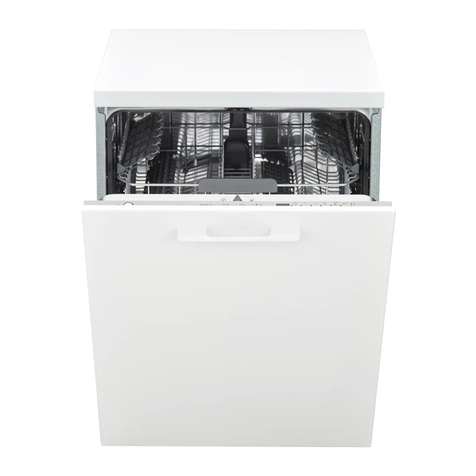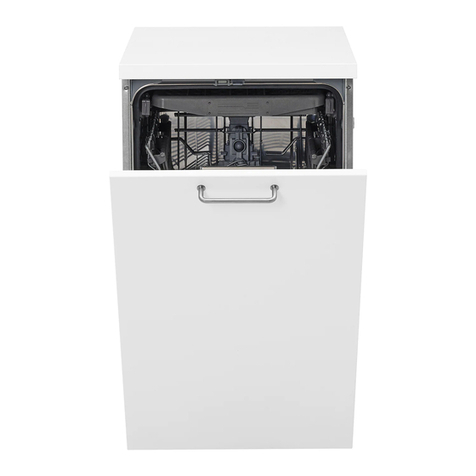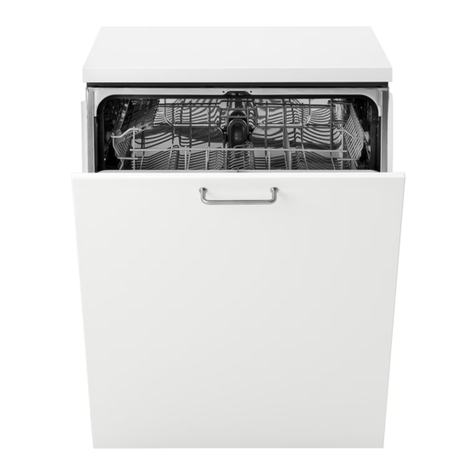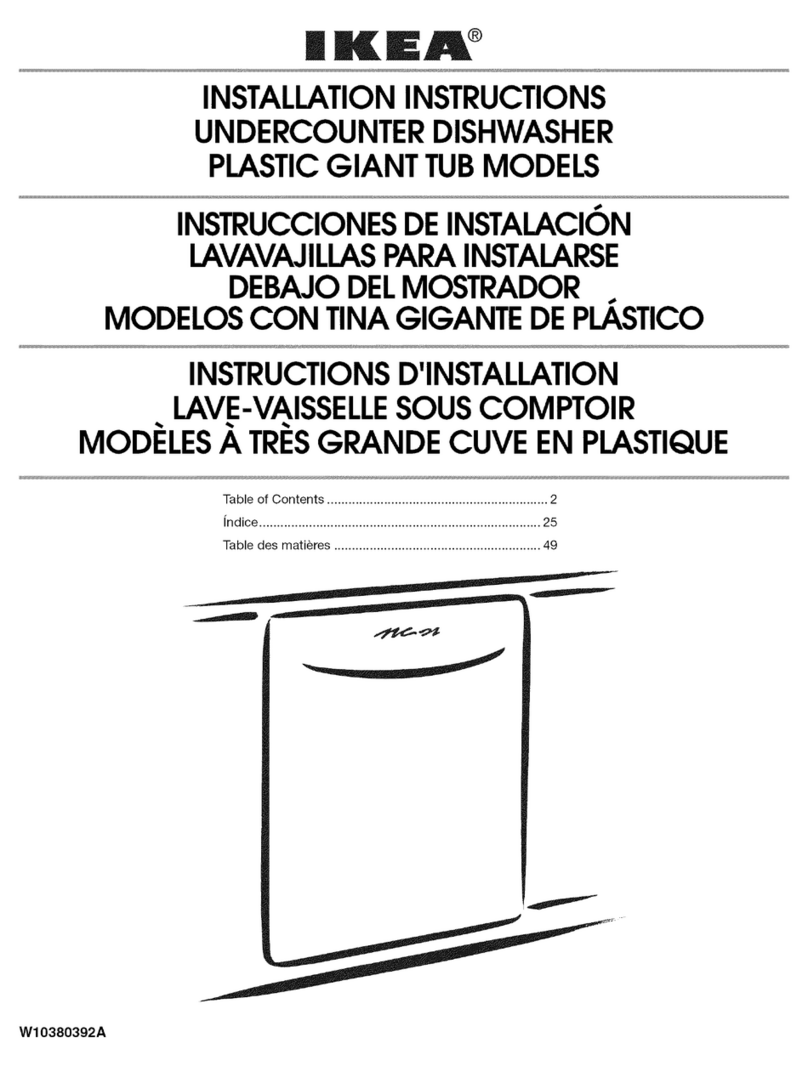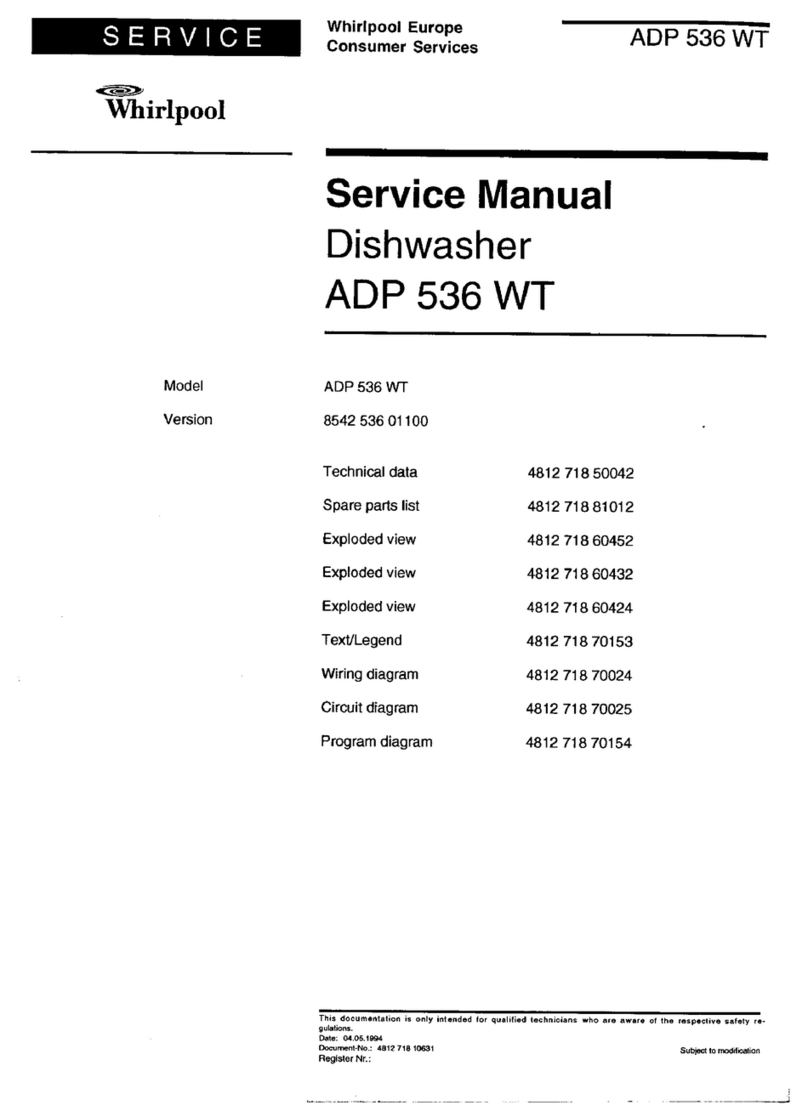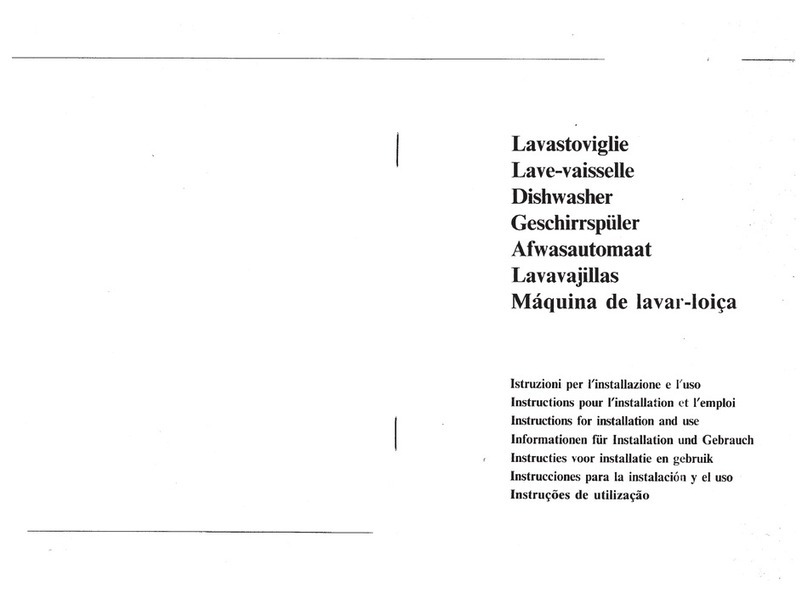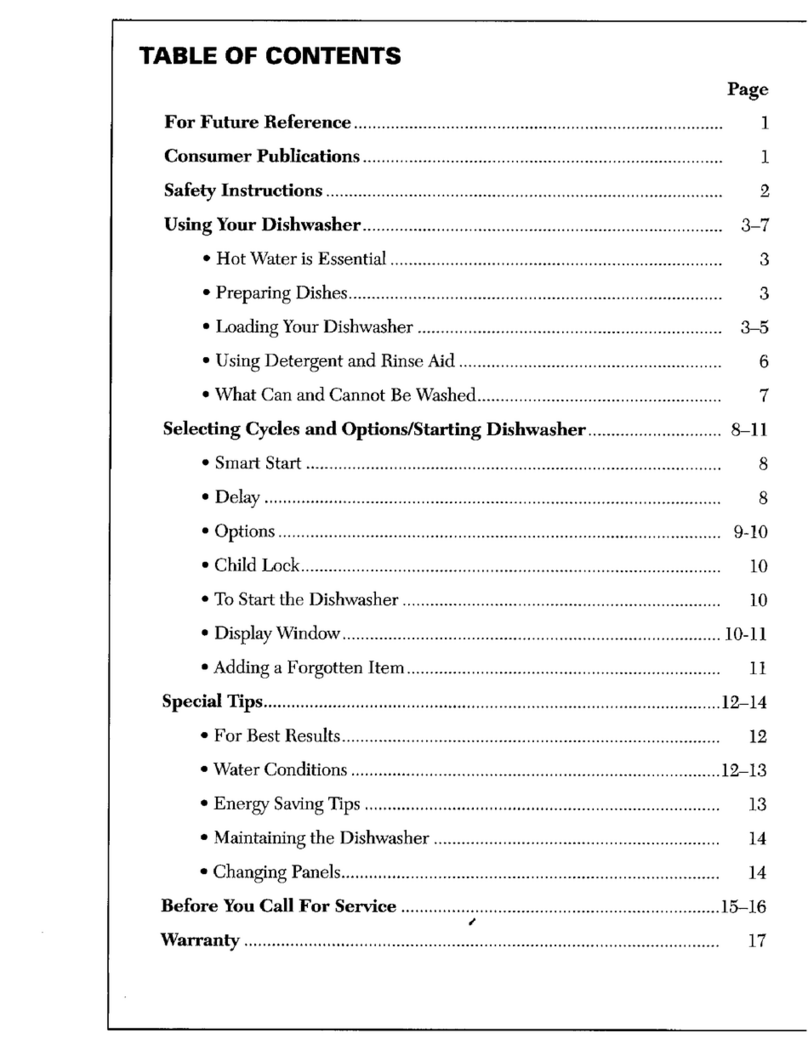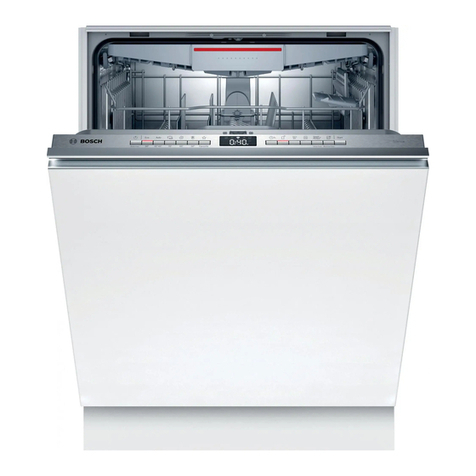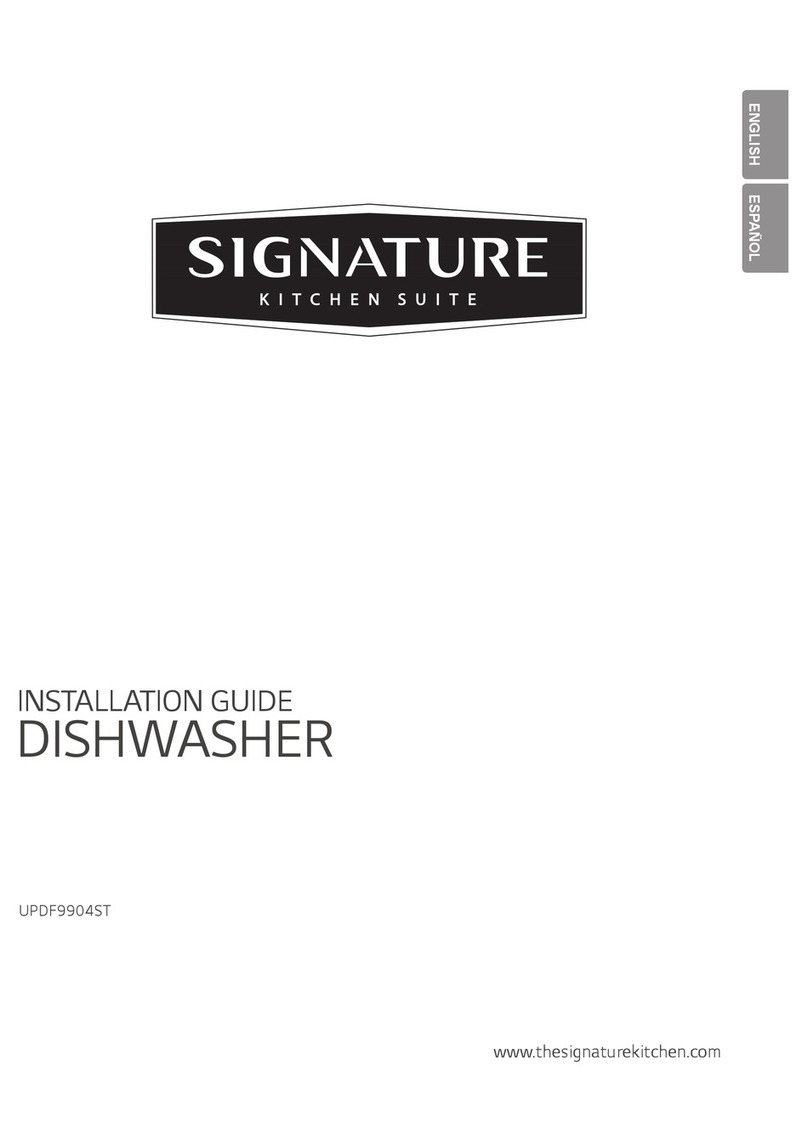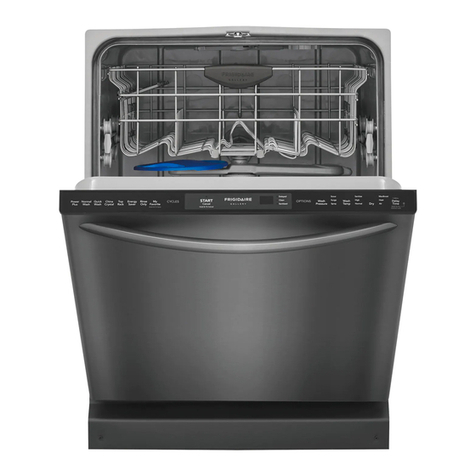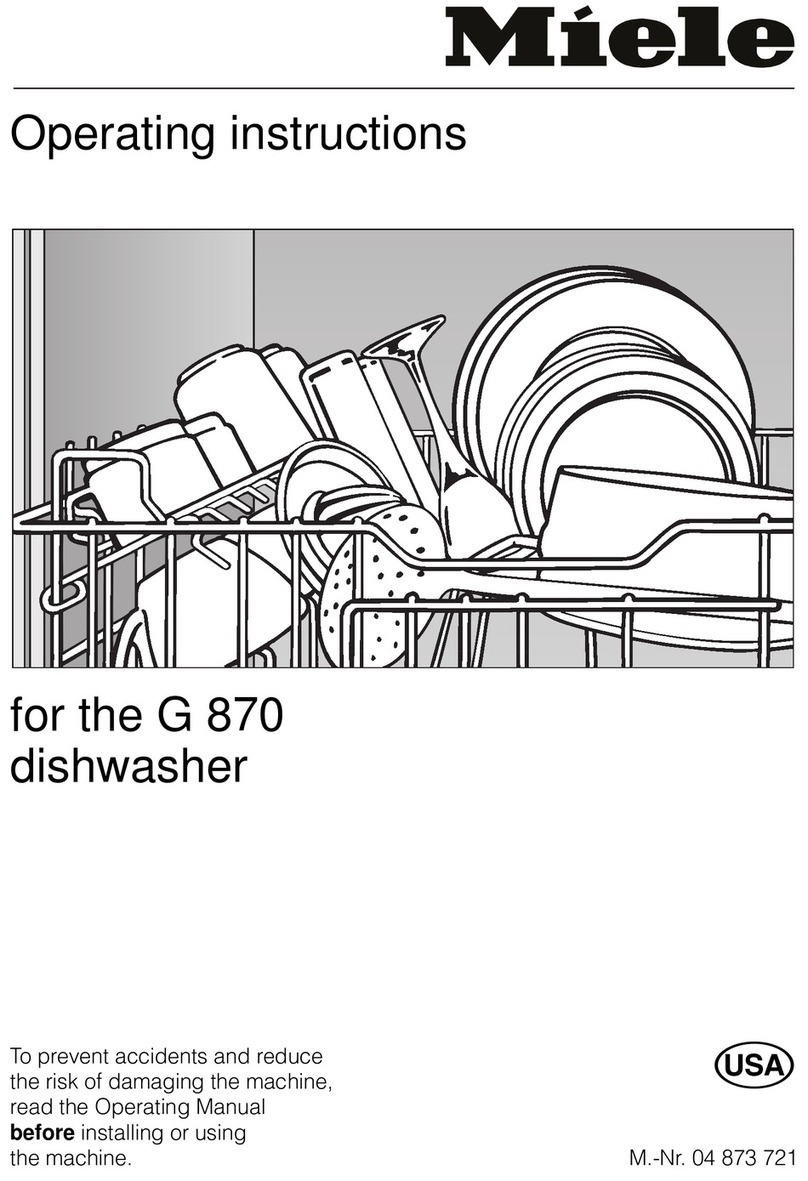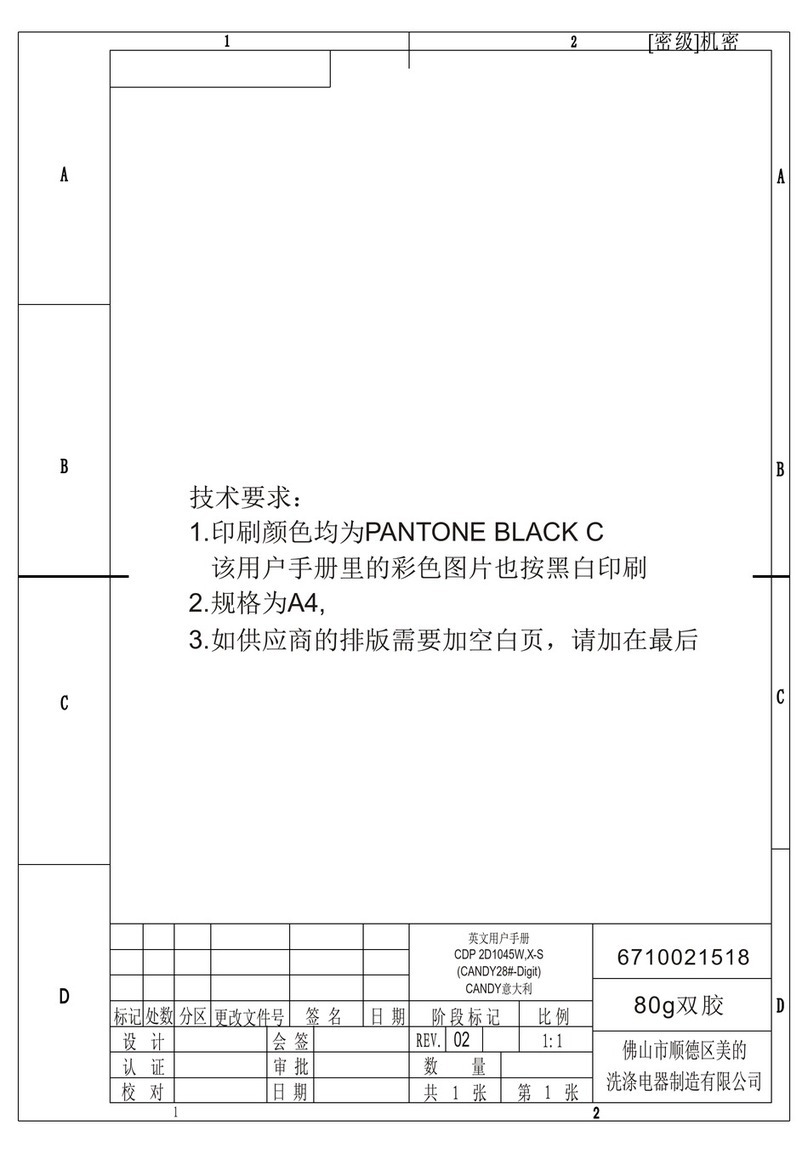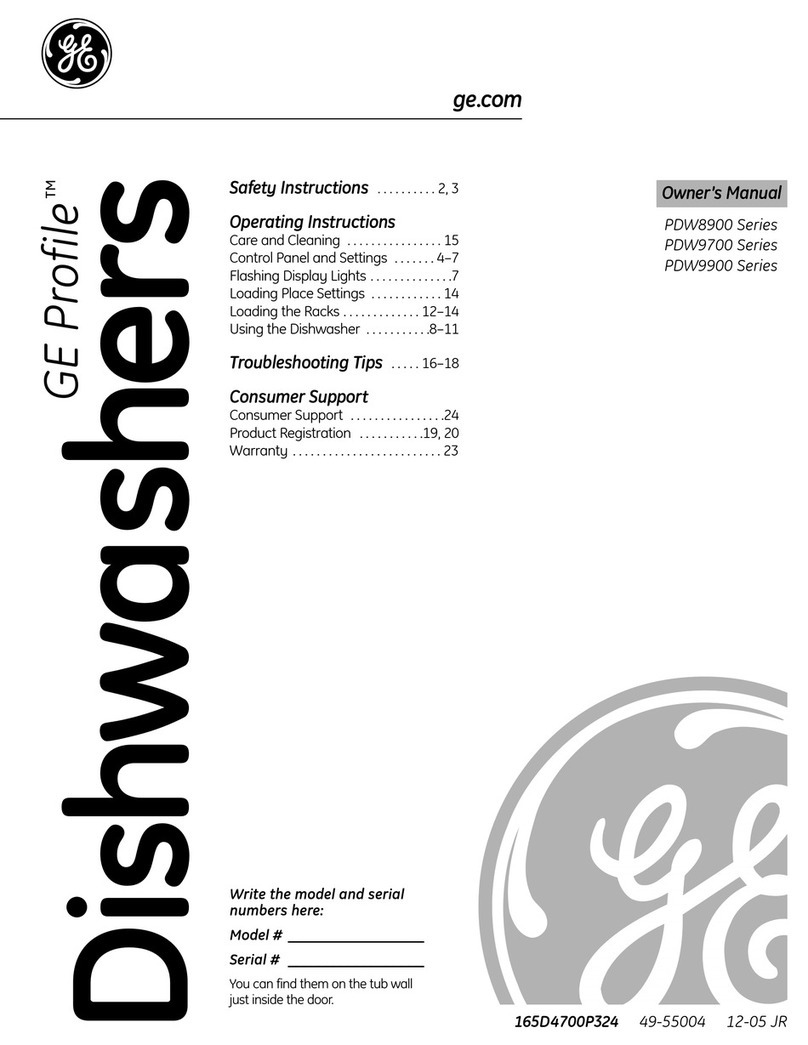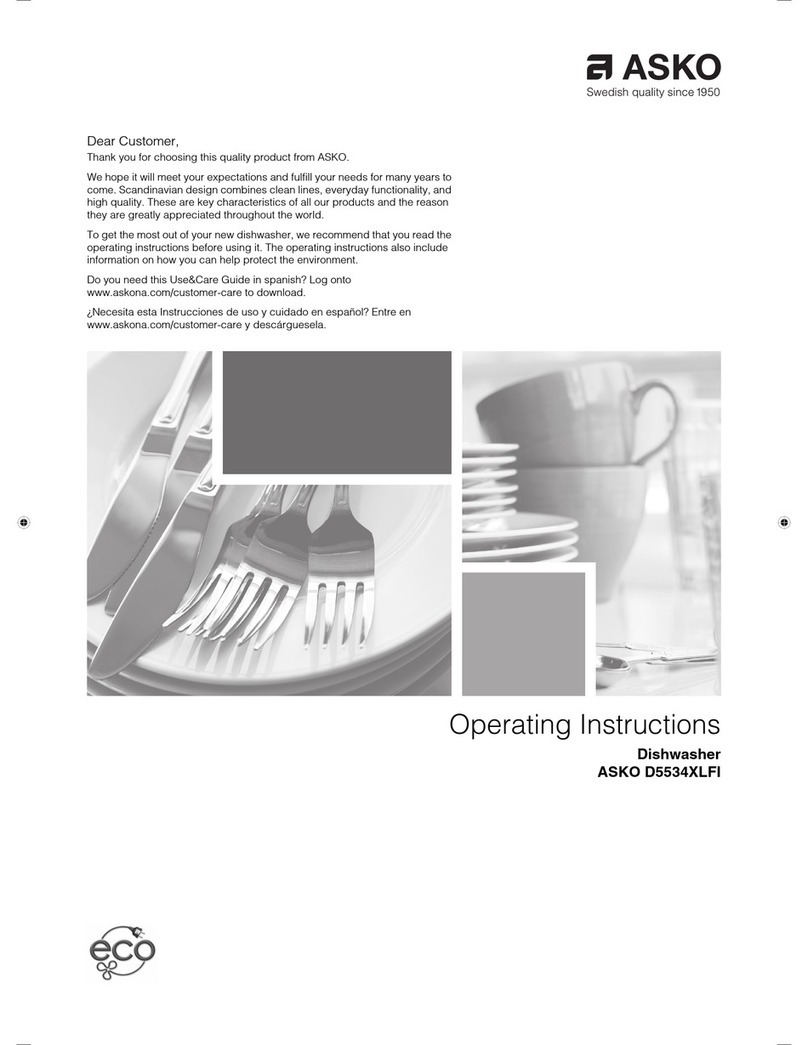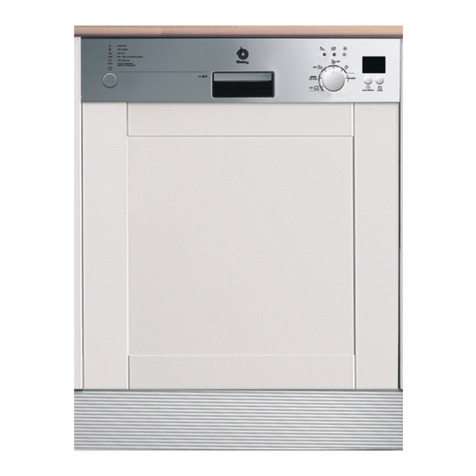IKEA RENGJORD User manual

ES
FR
EN
RENGJORD

3
EN
Thank you for choosing IKEA
This User Manual is part of our commitment
to customer satisfaction and product quality
throughout the service life of your new
appliance.
We view your purchase as the beginning
of a relationship. To ensure our ability to
continue serving you, please use this page
to record important product information.
_________________________________
Purchase Date
_________________________________
Model Number
_________________________________
Serial Number
NOTE
The dishwasher is programmed to
remember your last cycle so you do not
have to reset each time. To start the dish-
washer using the same cycle and options
selected on the previous wash, just press
the START button.
NOTE
Not all cycles and options available on all
models.
NOTE
Why Energy Ecient Units run long
cycles: Several factors are important to
washing dishware. The energy use of
the dishwasher was reduced by apply-
ing more of the factors that don’t use so
much energy and less of the ones that
use more. As a result, you will see that the
wash cycles take longer.
NOTE
Very Important Information
- Read Before Operating Your
Dishwasher!
Normal Operating Sounds
This dishwasher does not sound like most
dishwashers - IT’S QUIETER.
Your Direct Feed Wash System dishwash-
er uses energy ecient motors for the
wash and drain portions of the cycle you
select. Each cycle has a series of water
lls and drains for washing and rinsing
dishes. As each cycle begins, you may-or
may not- hear the drain motor. The next
sound you will hear is the splashing water
as it enters the tub.
PLEASE BE ADVISED: If you compare this
dishwasher to previous models, you may
be surprised at what you DON’T hear.
INTRODUCTION

4
EN
IMPORTANT SAFETY INFORMATION
WARNING
This symbols will help alert you to such
dangers as personal injury, burns, re
and electrical shock.
WARNING
To reduce the risk of re, electrical shock
or injury when using your dishwasher,
follow the above basic precautions .
SAVE THESE INSTRUCTIONS
WARNING
When using your dishwasher, follow basic
precautions, including the following:
Items that are not marked dishwasher
safe may melt and create a potential
re hazard.
• When loading items to be washed:
- Locate sharp items and knives so
that they are not likely to damage the
door seal or tub.
- Load sharp items and knives with
the handles up to reduce the risk of
cut type injuries.
• Do not tamper with controls.
• Use care unloading the dishware when
the SANITIZE option has been selected.
Contents may be hot to the touch
immediately after the end of cycle.
• Under certain conditions, hydrogen
gas may be produced in a hot water
system that has not been used for 2
weeks or more. HYDROGEN GAS IS
EXPLOSIVE. If hot water system has not
been used for such a period, before
using dishwasher, turn on all hot water
faucets and let water ow from each for
several minutes. This will release any
accumulated hydrogen gas. HYDROGEN
GAS IS FLAMMABLE. Do not smoke or
use an open ame during this time.
• Do not store or use combustible
materials, gasoline or other ammable
vapors and liquids in the vicinity of this
or any other appliance.
• Disconnect electrical power to
dishwasher before servicing.
• Repairs should be done by a qualied
technician.
• To avoid entrapment and/or
suocation, remove door or door latch
mechanism from any dishwasher that
is discarded or not in use.
For your Safety
• Use your dishwasher only as instructed in
this User Manual.
• This Manual does not cover every
possible condition and situation that
may occur. Use common sense and
caution when installing, operating and
maintaining any appliance.
• NSF certied residential dishwashers
are not intended for licensed food
establishments.
• DISHWASHER MUST BE ELECTRICALLY
GROUNDED. This appliance must
be connected to a ground metal,
permanent wiring system, or an
equipment-grounding conductor must
be run with the circuit conductors and
connected to the equipment-grounding
terminal or lead on this appliance. Read
the Assembly Instructions for details.
• This dishwasher is designed to operate on
regular house current (120V, 60Hz). Use
a circuit equipped with a 15 ampere fuse
or circuit breaker. Use a 20 ampere fuse
if dishwasher is connected with a food
disposer.
• Do not operate dishwasher unless all
enclosure panels are in their proper
place.
• Keep young children and infants away
from dishwasher when it is operating.
• Do not let children abuse, sit, stand or
play on door or racks of a dishwasher.
• To reduce the risk of injury, do not
allow children to play in or on the
dishwasher.
• Use only detergents and rinse agents
recommended for use in a dishwasher.
• Store dishwasher detergent and rinse
agents out of the reach of children.
• If the dishwasher drains into a food
disposer, make sure disposer is
completely empty before running
dishwasher.
• Do not wash plastic items unless
marked: “Dishwasher Safe” or
equivalent. Check with manufacturer
for recommendations, if not marked.

5
EN
Your dishwasher cleans by spraying a mixture of hot water and detergent through the
spray arms against soiled surfaces. First, the dishwasher drains for a few seconds to
remove soils dropped while loading, then lls with water covering the lter area. Water is
then pumped through the spray arms. Soil particles go through and across the lter and
down the drain as the water is pumped out. This series of steps are repeated as needed.
The number of water lls varies with the cycle being used.
Getting Started
1. Load Dishwasher (See Preparing and Loading Dishes).
2. Add detergent (See Dishwasher Dispenser & Detergents).
3. Add Rinse Aid, if needed (See Rinse Aid).
4. Run hot water faucet nearest dishwasher until water is hot. Turn water o.
5. Select desired CYCLE (See Cycle Chart).
6. Select desired OPTION (See Option Selections).
7. To start, press START button and close door immediately.
Features may vary according to model.
Rinse Aid
Dispenser
Tub Gasket
Middle Spray
Arm
Lower
Rack
Lower Spray
Arm
Detergent
Dispenser
Spray Arm
Upper Rack
Silverware
Basket
Filter
Serial Label
(located on
right side of
door)
Third level rack
FEATURES

6
EN
CAUTION
Property Damage Hazard
Before starting dishwasher be sure that
the water is connected and turned on.
Failure to do so may cause damage to the
pump seal and result in water leakage.
Wash Cycle Selections
Cycle times are approximate and will
vary with options selected. Hot water is
necessary to activate dishwasher detergent
and melt fatty food soils. An automatic
sensor will check the incoming water
temperature and, if it is not hot enough, the
cycle will be lengthened for automatic water
heating in the main wash and nal rinse of
all cycles. This happens even when HI-TEMP
WASH option has not be selected. When
HI-TEMP WASH is selected, an even higher
temperature will be reached to handle
heavier soil loads.
Option Selections
Wash Pressure
The programmed cycles default to the
“surge” pressure option which varies the
pressure optimally for the cycle’s intended
normal use. If a very low “spray” is desired,
press the WASH PRESSURE button. Due to
wash cycle optimization, some pressure
options are not selectable in all wash cycle.
Wash Temp
The programmed cycles default to the
“normal” temperature option, to choose HI-
TEMP or SANITIZE press WASH TEMP button
again.
Hi-Temp Wash Option
HI-TEMP WASH option is selected, by
pressing the WASH TEMP button. The
dishwasher heats water in the main wash
to approximately 140°F (60°C) and increases
the temperature higher in the nal rinse to
help with the drying stage.
This helps dishwasher detergent remove
food grease and soil from dishes more
eectively and aids in drying performance
by adding additional rinse aid and
increasing the water temperature.
Recommended Cycle for typical use:
The Normal cycle with its factory default
options of normal temperature and
heated dry together provide the best all
around performance. This cycle selection
is recommended for everyday use and is
suitable for a large range of both dish load
sizes and food quantities remaining on those
dishes.
Sanitize Option
To sanitize your dishes and glassware, select
SANITIZE option, by pressing WASH TEMP
button. When selected, the light will come
on and remain on until end of cycle. The
water temperature in the nal rinse will
be raised to 155°F (68°C) and will maintain
that temperature for 9 minutes. This option
is available in Heavy and Normal Cycles.
Only these sanitization cycles have been
designed to meet NSF requirements.
The cycle time will be extended until the
proper water temperature is reached.
Washing action will continue during the
water heating delay. For best results, the
incoming water temperature should be at
least 120°F (49°C).
The sanitize criteria may not be satised if
there is an interruption of the cycle, power
failure or if the incoming water temperature
is below 120°F (49°C).
To turn o the SANITIZE option, press the
Wash Temp button. The SANITIZE light will
turn o.
NOTE
The dishwasher checks the soil level on your dishes. In response, automatic cycle adjust-
ments are made to assure the dishwasher gets clean – with less food the cycle gets shorter.
Cycle time will also vary based on the options selected and the incoming water temperature.
CONTROLS & SETTINGS

7
EN
To Cancel a Cycle and Delay Start
Both running cycle and delay countdown
can be cancelled at any time.
Open the dishwasher door and press
the START button until you hear a tone.
The running cycle or delay countdown is
cancelled.
If desired, a new cycle can now be selected,
by pressing START button and closing the
door immediately, the new cycle will begin.
Delay Start
The DELAY START option allows you to
automatically delay starting your dishwasher
from 1-24 hours.
Select your desired cycle and options, then
press the DELAY START button until the
desired delay time displays in the status
window. The LEDs of selected cycle and
options are illuminated. The status window
displays the delay time and then displays
‘Press Start’.
To start the delay countdown, press START
button and close door immediately.
The status window displays ‘Close’ after the
START button is pressed.
A tone will sound indicating that the
countdown has started after the door is
closed. The selected cycle starts when the
countdown is completed.
Child Lock Controls
To prevent children from accidentally
changing the dishwasher cycle or starting
the dishwasher, lock the dishwasher controls
by pressing the DELAY START button until
the status window displays “loc”. To unlock
the controls, press the DELAY START button
until “loc” is no longer displayed in the status
window.
Heat Dry
The HEAT DRY option in combination with
rinse aid will enhance drying performance.
HEAT DRY option is available on all cycles.
Air Dry
The AIR DRY option will reduce temperature
in the hot rinse of the selected wash cycle.
This option will slightly decrease energy
usage but will increase the likelihood that
dishware will not be dry.
Opening the door during cycle
If door is opened while a cycle is running or
delay is counting down, the dishwasher will
stop running.
The LEDs of selected cycle and options are
illuminated, the status window displays
the remaining cycle time or delay time and
displays ‘Press Start’.
To resume, press START button and close
the dishwasher door immediately. The
status window displays ‘Close’ after the
START button is pressed.
A tone will sound indicating that the
dishwasher will begin running from the
point of interruption after the door is closed.
If the dishwasher door is kept open for too
long, or the door is closed without pressing
START button, the running cycle or delay
countdown will be cancelled.
Status Indicator Lights
The CLEAN light will remain on after door is
opened.
When the SANITIZE option is selected and
the criteria is met, the Sanitized indicator
will display and remain on after the door
is opened. If the sanitization criteria is not
achieved, the indicator will not display. This
can happen if the cycle is interrupted or if
the sanitization temperature could not be
reached due to incoming water temperature
signicantly below 120°F.
To Cancel a Setting
If you have selected your cycle and options
and decide to cancel, by pressing the START
button, the unit will go into a stand-by
mode, which all LEDs will go out.
CONTROLS & SETTINGS

8
EN
CONTROLS & SETTINGS
In all Error Code instances, if pressing the Cancel button or turning power o at the breaker
for 5 min. does not solve the problem, contact the Authorized Service Center stated in the
warranty section.
Error Code
Displayed
Error Code*
Problem Solution
i10 A low ll has been
detected.
Look for a pinched water supply line, or water
shuto is not completely opened.
i20; i40; iF0 Clogged lters or a
restricted drain line has
been detected.
Check and clean both lters and sump
area and check for a pinched or blocked
drain hose. If the drain line is attached to a
disposer, check that the knockout plug has
been removed.
i30 A leak or overow of
water has been detected
in the bottom pan.
Look for loose connections at the water inlet
valve and ensure the unit is properly leveled.
i50 A problem has been
detected with the drain
or wash motor.
Pressing the cancel button or turning power
o at the breaker for 5 min. should clear this
error code and the unit can be restarted.
If this does not resolve the problem,
service will need to be called.
i60 A problem has been
detected with the water
heating system.
iC0 A problem has been
detected with the
electronic control system.
Status Window
The STATUS window, available on some models, indicates the following activity:
User Instruction Code
1-24h Number of delay start hours.
The last hour will count down
in minutes.
CLOSE Close will scroll across the
status window indicating the
door needs to be closed.
MINUTES Number of minutes left in
cycle (1-199).
L0–L6. Level of Rinse Aid dosage.
Instruction
Code
Displayed
Problem/Condition Solution
Close This indicates the door
has been left open or
not properly latched.
Ensuring the door is properly latched will clear
the display. This does not indicate a problem
with your dishwasher and service will not need
to be contacted.
PF Soft Power Failure: PF is displayed if a power outage occurs during a wash
cycle. The wash cycle will be paused temporarily and resume once power is
restored if the door has not been opened.
Hard Power Failure: A hard power failure means the unit will not operate
until power is restored. Pressing start within 18 hours of loss of power will
resume power at the point of cycle interruption.

9
EN CONTROLS & SETTINGS
Cycle Chart
Cycle Settings Water
(approx.)
Time *
(Hours)
Washes/
Rinses
Heavy
For pots, pans cas-
seroles and dinner-
ware with dried-on or
baked-on soils, and
silverware
Default
Surge, Hi-Temp, and
Heat
Options
Sanitize, and Air
7.0 - 7.9 gal.
26.6 - 29.9 liters
2 1/4- 3 1/44 Washes
3 Rinses
Normal
For regularly soiled
dishes and silverware.
Default
Surge, Normal, and
Heat
Options
Spray, Hi-Temp
Sanitize, and Air
2.9 - 7.3 gal.
11.0 - 27.7 liters
2 - 3 1/45 Washes
2 Rinses
China Crystal
For lightly soiled China
and Crystal
Default
Spray, Normal, and
Heat
Options
None Available
5.7 gal.
21.5 liters
1 1/43 Washes
2 Rinses
Energy Saver
For lightly soiled
pre-rinsed dishes and
silverware
Default
Surge, Normal, and
Air
Options
Spray
4.4 - 7.9 gal.
16.5 - 29.7 liters
1 1/4- 1 3/45 Washes
3 Rinses
Rinse Only
For rinsing dishes that
will be washed later.
Default
Surge
Options
None Available
2.0 gal.
7.6 liters
1/42 Rinses
NOTE*
The time remaining may suddenly increase or drop several minutes. This means that
the dishwasher received input from the Smart Sensor concerning the soil load and has
automatically adjusted the cycle length.

10
EN
OPERATING INSTRUCTIONS
Dish Preparation
Scrape away large pieces of food, bones,
pits, toothpicks, etc. The continuously
ltered wash uid will remove remaining
food particles. Burned-on foods should be
loosened before loading. Empty liquids from
glasses and cups.
Foods such as mustard, mayonnaise,
vinegar, lemon juice and tomato based
products may cause discoloration of
stainless steel and plastics if allowed to
sit for a long period of time. Unless the
dishwasher is to be operated at once, it is
best to pre-rinse or use the rinse only cycle
to rinse o these food soils.
• Load racks so that large items do not
prevent the detergent dispenser from
opening.
• Check manufacturer’s
recommendations before washing
items in question.
• If the dishwasher drains into a
Food Disposer, be sure disposer is
completely empty before starting
dishwasher.
Loading the Upper Rack
Features and appearance of racks and
silverware basket may vary from your
model.
The upper rack is designed for exibility in
loading a wide variety of items including
cups, glasses, stemware, small plates,
bowls, etc.
Load glasses and plastic items in upper rack
only.
Load items with open end facing down for
better cleaning and draining.
Damage may occur if delicate items touch
each other during dishwasher operation.
Long-handled knives and utensils can be
placed in upper rack.
Be sure nothing protrudes through the
bottom of the rack to block rotation of
middle spray arm.
10 place settings standard loading pattern
12 place settings standard loading pattern
8 place settings standard loading pattern

11
EN OPERATING INSTRUCTIONS
Loading the Bottom Rack
Features and appearance of racks
and silverware basket may vary from
your model.
The bottom rack is best for plates, saucers,
bowls, and cookware. Large items should be
placed along the edge so they do not block
the spray arm rotation. For best results,
place bowls, casseroles, and sauce pans with
soiled surface facing down or toward the
center. Tilt slightly for better drainage.
Make sure tall items do not block spray arm
rotation.
Be sure pan handles do not protrude
through the bottom of the rack and block
the spray arm rotation.
12 place settings standard loading pattern
8 place settings standard loading pattern.
10 place settings standard loading pattern.

12
EN
OPERATING INSTRUCTIONS
Mix items in each section of the basket with
some pointing up and some down to avoid
nesting. Water spray cannot reach nested
items.
Adding an article
To add or remove items after wash cycle
starts:
• Unlatch door and wait a few seconds
until wash action stops before opening.
• Add the item and wait a few seconds to
allow cold air to slowly expand inside
dishwasher.
• To resume cycle press the START button
and close the door immediately.
CAUTION
Load sharp items (knives, skewers, etc.)
pointing down.
Failure to do so may result in injury.
Features and appearance of racks and
silverware basket may vary from your
model.
Load the silverware basket while it is in
the bottom rack or take the basket out for
loading on a counter or table.
In some models small items like baby bottle
caps, jar lids, corn cob holders, etc., can be
placed in a covered section. Close the cover
to hold small items in place.
Use suggested loading patterns, as shown,
to increase washability of the silverware.
• Be sure nothing protrudes through
bottom of basket or rack to block the
spray arm.
• Do not mix silver and stainless to avoid
damaging the silver nish
Loading the Silverware Basket
Loading the Cutlery Tray
The Cutlery Tray is designed for atware
and most cooking or serving utensils.
Heavily soiled utensils or items with baked
on foods should be placed in the upper
rack or silverware basket for best washing
performance. The separators on the cutlery
tray help keep atware separated to avoid
damage and improve cleaning.

13
EN OPERATING INSTRUCTIONS
CAUTION
The use of industrial grade detergent can
damage parts of the dishwasher leading
to damage to the unit and surrounding
property. Use only household grade
automatic dishwasher detergents.
How much Detergent to use
The amount of detergent to use depends
on the water hardness. Water hardness is
measured in grains per gallon. Using too
little detergent can result in poor cleaning
and hard water lming or spotting. Using
too much detergent in soft water can cause
etching to some glassware which is surface
damage that appears like a lm but cannot
be wiped o. You can also determine the
water hardness with a water hardness test
kit from a hardware store.
Main Wash Cup
Main Wash Cover
Cover
Latch
NOTE
Hard water may cause lime deposit
buildup on the interior of the dishwasher.
For cleaning instructions see “Removing
Spots and lm” section.
NOTE
Detergent tablets and All-In-One packs may
not dissolve completely if used with the
QUICK WASH cycles. If one of these prod-
ucts are used, place the tab or pack directly
on the bottom of the tub in a corner before
starting the dishwasher, rather than placing
these products in the dispenser.
Filling the Detergent Dispenser
The detergent dispenser has a main wash
cup where you will add your detergent or
detergent tab.
• Use only fresh automatic dishwashing
detergent. Other detergents may cause
oversudsing.
• When using automatic dishwashing
detergent tablet, place one tablet in
main wash cup and close.
• Add detergent just before starting
cycle.
• Store detergent in a cool, dry location.
Moist or caked detergent may not
dissolve properly.
To add detergent:
1. Press the dispenser cover latch to open
the main wash detergent cup.
2. Add the recommended amount of
detergent to the main wash cup.
3. Slide the main wash cover back over the
main wash cup to close.

14
EN
Detergent Usage Chart
Dosage of Detergent
Place a single detergent tablet or packet into the detergent dispenser compartment.
Water Hardness Soft Water
(0-3 grains)
Medium Hard Water
(4-8 grains)
Hard Water
(9-12 grains)
Amount of detergent
(teaspoons)
4 teaspoons 6 teaspoons 8 teaspoons
Dispenser cup level First Line Second Line Full
NOTE
For very hard water, detergent alone may not be enough. A water softener is recom-
mended to improve water quality and dishwashing performance. Try adding more deter-
gent at the beginning of the main wash portion of the cycle. As a rule, use 1 teaspoon for
each grain above 12. Unlatch the door, open slowly and add detergent to the bottom of
the tub. Close the door to latch and the dishwasher will continue through the cycle.
OPERATING INSTRUCTIONS

15
EN
IMPORTANT
Before starting a cycle, run hot water to
clear cool water from pipe.
Water Pressure
The hot water line to dishwasher must
provide water pressure between 20 and 120
psi.
Low water pressure may occur when
laundry or showers are in operation. If you
experience poor wash performance you
may need to wait until water use is reduced
before starting the dishwasher.
How to adjust the rinse aid
dosage
Press and hold the RINSE ONLY and DELAY
START button for 5 seconds until the status
window shows rinse aid level. Pressing
the DELAY START button increases the
increment level (L0-L6).
Once the rinse-aid level reaches L6, the
status window will start back at level L0.
Pressing the START button or just pausing
for a few seconds conrms the rinse aid
level setting: the status window shows the
duration of the cycle.
Water Temperature
Hot water is needed for best dishwashing
and drying results. Water entering
dishwasher should be at least 120°F (49°C)
to give satisfactory results.
To check water temperature entering
dishwasher:
• Turn on hot water faucet nearest
dishwasher for several minutes to clear
cool water from pipes.
• Hold a candy or meat thermometer
in the water stream to check the
temperature.
• If temperature is below 120°F (49°C),
have a qualied person raise the hot
water heater thermostat setting.
Indicator
Rinse Aid
Compart-
ment
Rinse Aid
Cover
Rinse Aid
Rinse aid greatly improves drying,
reduces water spots, lming. With
it water “sheets” o dishes rather than
forming water droplets that cling and leave
spots.
A dispenser, located next to the detergent
cup, automatically releases a measured
amount of rinse aid during the last rinse.
If spotting and poor drying are problems,
increase the amount of rinse aid dispensed.
The indicator will be dark when full and will
show clear when it is time to rell.
To add liquid rinse aid:
1. Lift up the rinse aid cover to open.
2. Fill the rinse aid dispenser with liquid
rinse aid until the liquid reaches the
indicated ll level. DO NOT overll.
3. Press the rinse aid cover down rmly to
close.
4. Wipe up any spills with a damp cloth.
The dispenser holds enough for 11 to 66
washes, depending on setting.
NOTE
The HEAT DRY option in combination with
rinse aid will enhance drying performance.
The energy required to use the HEAT DRY
option costs pennies per cycle. You may
choose not to select the HEAT DRY option;
however you will have items in your dish
load that will not be completely dry at the
end of the cycle.
OPERATING INSTRUCTIONS

16
EN
CARE AND CLEANING
Clean the Coarse Filter
Take out the Cylinder Fine Filter and remove
the Coarse Filter from the dishwasher tub
bottom. Flush the Coarse Filter by holding it
under running water and replace.
Clean the Cylinder Fine Filter
The Cylinder Fine Filter is designed to collect
some big items such as broken glass, bones
and pits. The Cylinder Fine Filter needs to be
cleaned to maximize wash performance.
Remove the Cylinder Fine Filter as shown,
rotate it counterclockwise, lift it out, empty
and clean it by rinsing under running water
and replace. Use of a sponge or bottle
brush may be necessary to remove all food
residue.
Outside
Occasionally wipe with a mild nonabrasive
detergent and water. Rinse and dry.
Care of Drain Air Gap
If a drain air gap was installed for your
built-in dishwasher, check to make sure it is
clean so the dishwasher will drain properly.
A drain air gap is usually mounted on
the counter top and can be inspected by
removing the cover. This is not part of your
dishwasher and is not covered by warranty.
NOTE
Cleaning of console surfaces must be
carried out only with lukewarm water and
neutral soaps.

17
EN CARE AND CLEANING
Winterizing
A dishwasher left in an unheated place
should be protected from freezing. Have a
qualied person do the following:
To Disconnect Service:
1. Turn o electrical power to the
dishwasher at the supply source by
removing fuses or tripping circuit
breaker.
2. Shut o water supply.
3. Place a pan under the inlet valve.
Disconnect water line from the inlet
valve and drain into pan.
4. Disconnect drain line from pump and
drain water into pan.
To Restore Service:
1. Reconnect the water, drain, and
electrical power supply.
2. Turn on water and electrical power
supply
3. Fill detergent cup and run the
dishwasher through a HEAVY cycle.
4. Check connections to make sure they
do not leak.
CAUTION
Property Damage Hazard
Freezing temperatures may cause water
lines to rupture. Be sure all supply lines
to and circulating lines within dishwasher
are protected.
Failure to do so could result in property
damage.
NOTE
See Assembly Instructions for more
details on disconnecting and restoring
service to your dishwasher.

18
EN
TROUBLESHOOTING
Before calling for service, review this list. It
may save you both time and expense. This
list includes common experiences that are
not the result of defective workmanship or
material in your dishwasher.
Food Soils Left on Dishes
• Choose another cycle for longer
washing time.
• Choose the Hi-Temp Wash option.
• Check rack loading section for proper
loading-avoid nesting items.
• Home water pressure may be too low -
should be 20 to 120 pounds per square
inch (psi).
• Check incoming water temperature.
It should be at least 120°F (49°C). (See
Factors Aecting Performance.)
• Check water hardness. For extremely
hard water, it may be necessary to
install a water softener. (See Detergent
Chart).
• Use Fresh Detergent.
• Make sure items are not blocking the
spray arms, preventing them from
rotating.
Dishes not Dry
• Select heat dry option.
• Make sure the rinse aid dispenser is lled.
• Increase the discharge setting of rinse
aid. (See Rinse Aid).
• Check the incoming water temperature.
Be sure it is at least 120°F (49°C).
• Check for proper loading-avoid nesting
items.
• Plastic items may need to be towel dried.
• Cups with a concave bottom will collect
water. Load them at the far left of the
upper rack so they will be held in a
tilted position.
Glassware/Flatware Spotted or Cloudy
• Check water hardness. For extremely
hard water, it may be necessary to install
a water softener. (See Detergent Chart).
• Water temperature may be low. Avoid
extremely low or high temperatures.
(See Factors Aecting Performance.
• Avoid overloading and improper loading.
(See Preparing and Loading Dishes).
• Use fresh detergent. Old detergent is
ineective.
• Make sure rinse aid dispenser is lled.
• Check to see that proper amount
of detergent is being used for cycle
selected. Also, check phosphate level.
(See Detergent Dispenser.)
• Home water pressure may be too low
- it should be 20 to 120 pounds per
square inch (psi).
Dishware Chipped
• Load with care and do not overload.
(See Preparing and Loading Dishes).
• Place delicate items in top rack.
• Place glasses securely against pins and
not over pins.
• Load items so they are secure and don’t
jar loose when moving racks in and out.
Move racks in and out slowly.
• Make sure tall glasses and stemware will
clear top of tub when rack is pushed in.
• Fine antique china and crystal should be
hand-washed.
Water in Bottom of Tub
• Water left in the tub bottom after the
cycle is complete is not normal. If water
remains in the bottom of the tub,
the dishwasher may not be draining
properly. (See Dishwasher Does not
Drain Properly).
Dishware Stained or Discolored
• Tea and coee can stain cups. Remove
the stains by hand washing in a solution
of 1/2 cup (120 ml) bleach and one quart
(1L) of warm water. Rinse thoroughly.
• Iron deposits in water can cause a
yellow or brown lm. A special lter
installed in the water supply line will
correct this problem. (See Removing
Spots and Film).
• Aluminum utensils can leave gray/black
marks when they rub against other
items. Load Properly.
• Certain high acid foods can cause
discoloration of stainless steel and
plastics if allowed to sit for a long period.
Use the Rinse Only cycle or rinse by hand
if not operating dishwasher at once.
• Mixing stainless steel and silver utensils
in silverware basket can cause pitting of
the stainless steel blades. Avoid mixing
stainless steel and silver.
Cycle Takes a Long Time
• Is cycle in a water heating delay?
• Has the delay start option been selected?
• Has the sanitize option been selected?
Normal Sounds You Will Hear
• Normal sounds include water ll, water
circulation and motor sounds.

19
EN TROUBLESHOOTING
Removing Spots and Film
Hard water can cause lime deposit buildup
on the interior of the dishwasher. Dishes
and glasses may also get spots and lm
for a number of reasons. (See Glassware/
Flatware Spotted or Cloudy section). To
remove buildup, and lm, clean using the
following instructions:
1. Load clean dishes and glasses in normal
manner. Do not load any metal utensils
or silverware.
2. Do not add detergent.
3. Select the NORMAL cycle. Press START
button. Close and latch the door.
4. Allow dishwasher to run until it starts
the second water ll (approximately 10
minutes).
5. Unlatch an and open door and pour 2
cups of white vinegar into the bottom of
dishwasher.
6. Close and latch door and allow cycle to
nish.
Dishwasher Leaks
• Use only fresh detergent designed
for automatic dishwashers. Measure
detergent carefully. Try a dierent
brand.
Etching
• Using too much detergent especially in
soft or softened water causes damage
that looks like a lm but cannot be
removed.
• Adjust the amount of detergent
based on the water hardness. (Check
Detergent Chart).
• Lower the water temperature.
Detergent Left in Dispenser Cup
• Detergent may be old. Discard and use
fresh detergent.
• Be sure the dish load doesn’t block
spray from entering the detergent cup.
• Check to see if cycle has been
completed.
• Make sure items do not prevent the
detergent dispenser from opening.
Vapor at Vent
• Spilled rinse aid can cause foam and
lead to overowing. Wipe up any spills
with a damp cloth.
• Water vapor escapes from the vent
during the drying part of the cycle. This
is normal.
• Check to see that dishwasher is level.
(See Assembly Instructions).
Dishwasher Won’t Run
• Check to see if circuit breaker is tripped
or if a fuse is blown.
• Make sure water supply is turned on.
• Check to see if cycle is set correctly. (See
Operating Instructions).
• Is dishwasher set for Delay Start Option?
• Make sure door is closed and latched.
Dishwasher Won’t Fill
• Is water supply turned on?
Dishwasher Does Not Drain Properly
• If unit is hooked up to a food waste
disposer, make sure the disposer is
empty.
• Check to see if the knockout plug has
been removed from inside the food
waste disposer inlet.
• Check to see if drain hose is kinked.
• Make sure cycle is complete, not in a
pause.
Dishwasher has an Odor
• Soiled dishes left in dishwasher too
long can create an odor. Use Rinse Only
cycle.
• There will be a “new” smell when rst
installed. This is normal.
• Check to see if unit is draining properly.
(See Dishwasher Does Not Drain
Properly).
Stains on Tub Interior
• Washing large amounts of dishware
with tomato based soil can cause a
pink/orange appearance. This will not
aect performance and will gradually
fade over time. Pre-rinsing or using the
Rinse Only cycle will reduce the chance
of staining. Using air dry option will
lessen staining.
Opening the door during cycle
• If the dishwasher door is opened while
the unit is running, the START button
must be pressed and the door shut
immediately to return the unit to the
selected cycle and option.

20
EN
LIMITED WARRANTY
How long is the IKEA guarantee valid?
This guarantee is valid for ve (5) years from the original date of purchase of Your
appliance at IKEA. The original sales receipt is required as proof of purchase. If ser-
vice work is carried out under guarantee, this will not extend the guarantee period
for the appliance.
Who will execute the service?
IKEA Service Provider will provide the service through its own service operations or autho-
rized service partner network.
What does this guarantee cover?
The guarantee covers faults of the appliance which have been caused by faulty construction or
material faults from the date of purchase from IKEA. This guarantee applies to domestic use
only. Some exceptions not guaranteed are specied under the headline “What is not covered
under this guarantee?” Within the guarantee period, the costs to remedy the fault (e.g., repairs,
parts, labour and travel) will be covered, provided that the appliance is accessible for repair
without special expenditure. On these conditions the local regulations are applicable. Replaced
parts become the property of IKEA.
What will IKEA do to correct the problem?
IKEA appointed Service Provider will examine the product and decide, at its sole discretion,
if it is covered under this guarantee. If considered covered, IKEA Service Provider or its au-
thorized service partner through its own service operations, will then, at its sole discretion,
either repair the defective product or replace it with the same or a comparable product.
What is not covered under this guarantee?
• Normal wear and tear.
• Deliberate or negligent damage, damage caused by failure to observe operating
instructions, incorrect installation or by connection to the wrong voltage, dam-
age caused by chemical or electrochemical reaction, rust, corrosion or water
damage including but not limited to damage caused by excessive lime in the
water supply, damage caused by abnormal environmental conditions.
• Consumable parts including batteries and lamps.
• Non-functional and decorative parts which do not aect normal use of the appliance,
including any scratches and possible colour dierences.
• Accidental damage caused by foreign objects or substances and cleaning or unblock-
ing of lters, drainage systems or soap drawers.
• Damage to the following parts: ceramic glass, accessories, crockery and cutlery bas-
kets, feed and drainage pipes, seals, lamps and lamp covers, screens, knobs, casings
and parts of casings. Unless such damages can be proved to have been caused by
production faults.
• Cases where no fault could be found during a technician’s visit.
• Repairs not carried out by our appointed service providers and/or an authorized ser-
vice contractual partner or where non-original parts have been used.
• Repairs caused by installation which is faulty or not according to specication.
• The use of the appliance in a non-domestic environment i.e. professional use.
• Transportation damages. If a customer transports the product to his home or an-
other address, IKEA is not liable for any damage that may occur during transport.
However, if IKEA delivers the product to the customer’s delivery address, then
damage to the product that occurs during this delivery will be covered by IKEA.
• Cost for carrying out the initial installation of the IKEA appliance. However, if
an IKEA appointed Service Provider or its authorized service partner repairs or
replaces the appliance under the terms of this guarantee, the appointed Service
Provider or its authorized service partner will reinstall the repaired appliance or
install the replacement, if necessary.
Other manuals for RENGJORD
1
Table of contents
Other IKEA Dishwasher manuals

IKEA
IKEA SKINANDE User manual
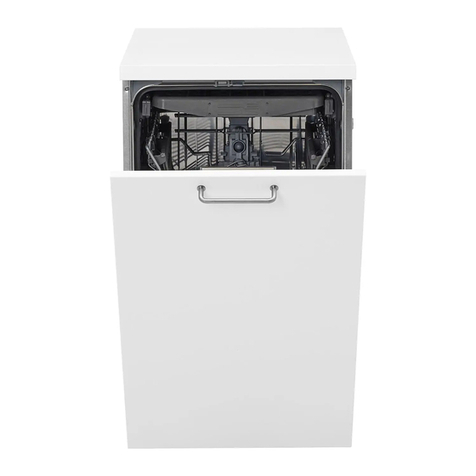
IKEA
IKEA FINPUTSAD 700 User manual

IKEA
IKEA RENLIG DWTI60 User manual

IKEA
IKEA IDT930SAGX0 User manual

IKEA
IKEA TORSBODA User manual

IKEA
IKEA W11212416C User manual

IKEA
IKEA NUTID DW60 User manual
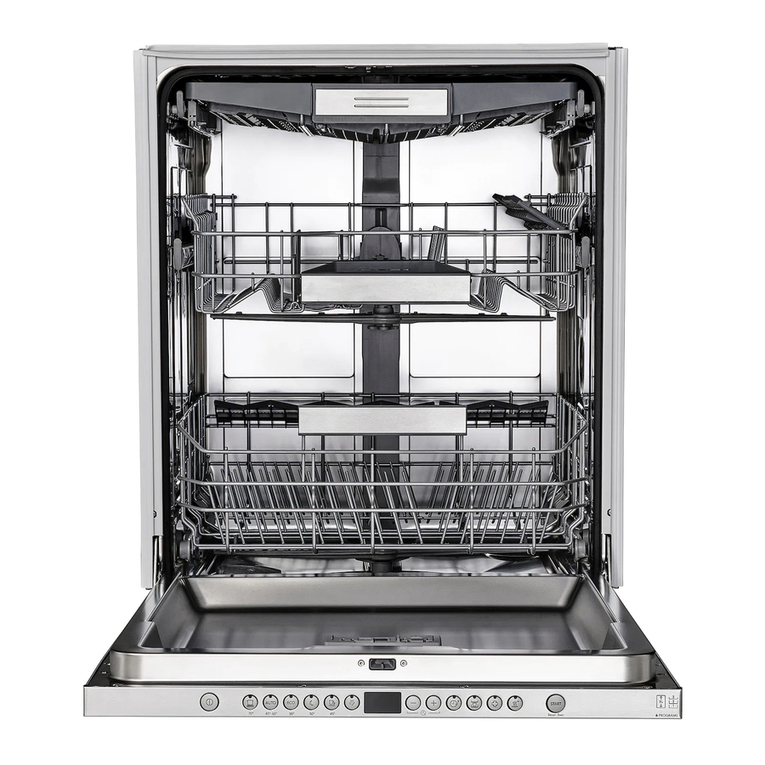
IKEA
IKEA PROFFSIG User manual

IKEA
IKEA LAGAN User manual

IKEA
IKEA LAGAN User manual

